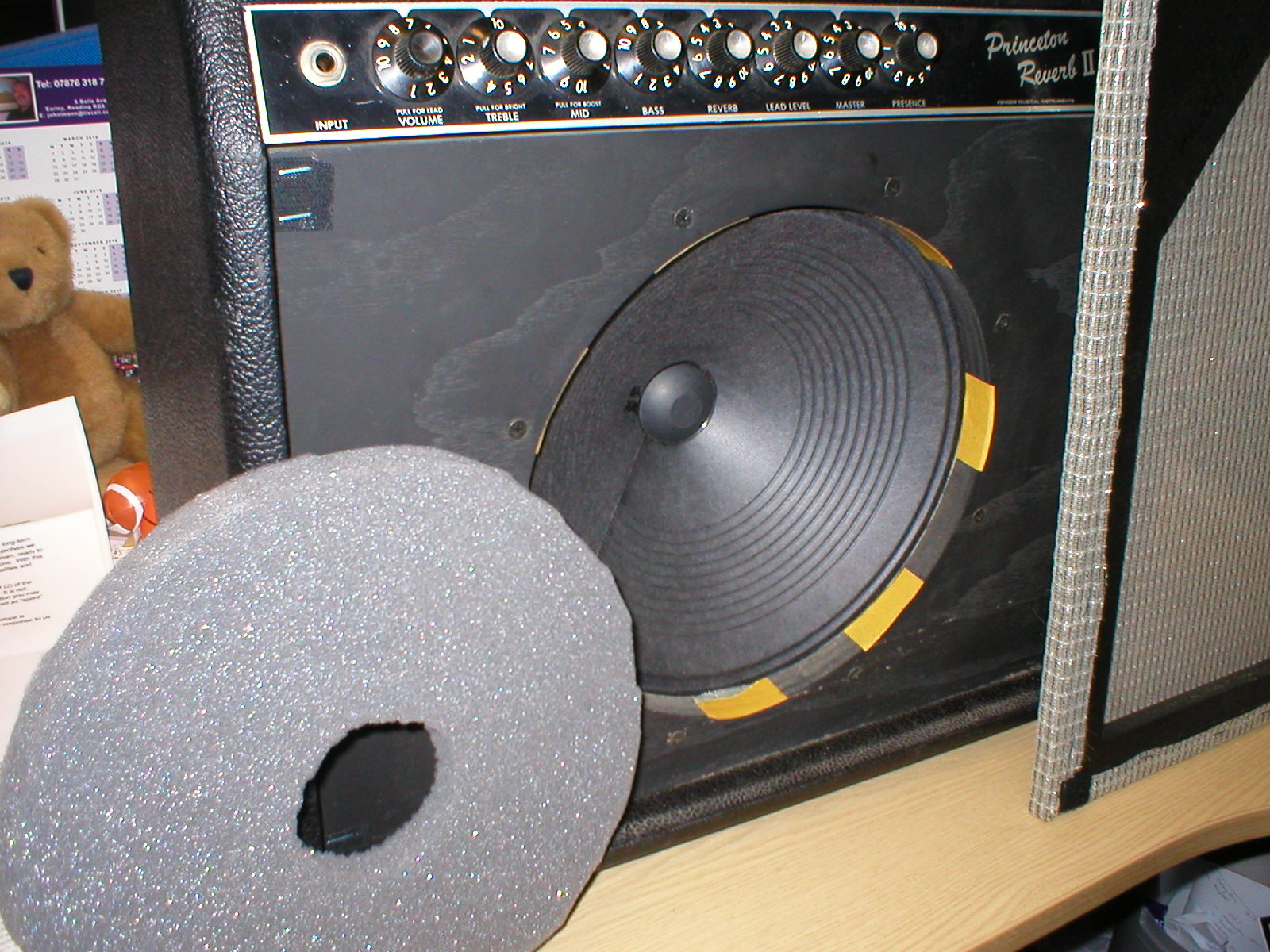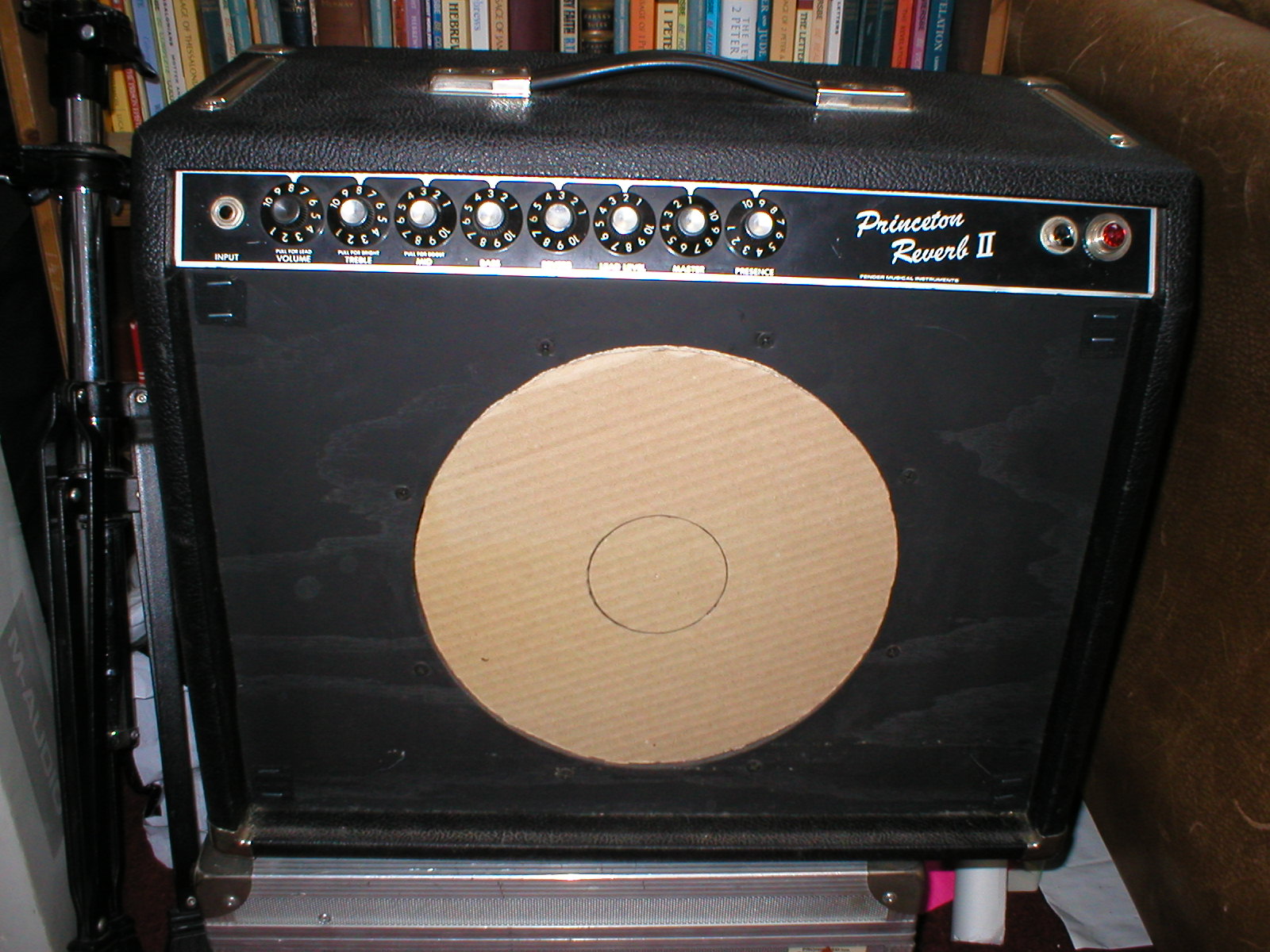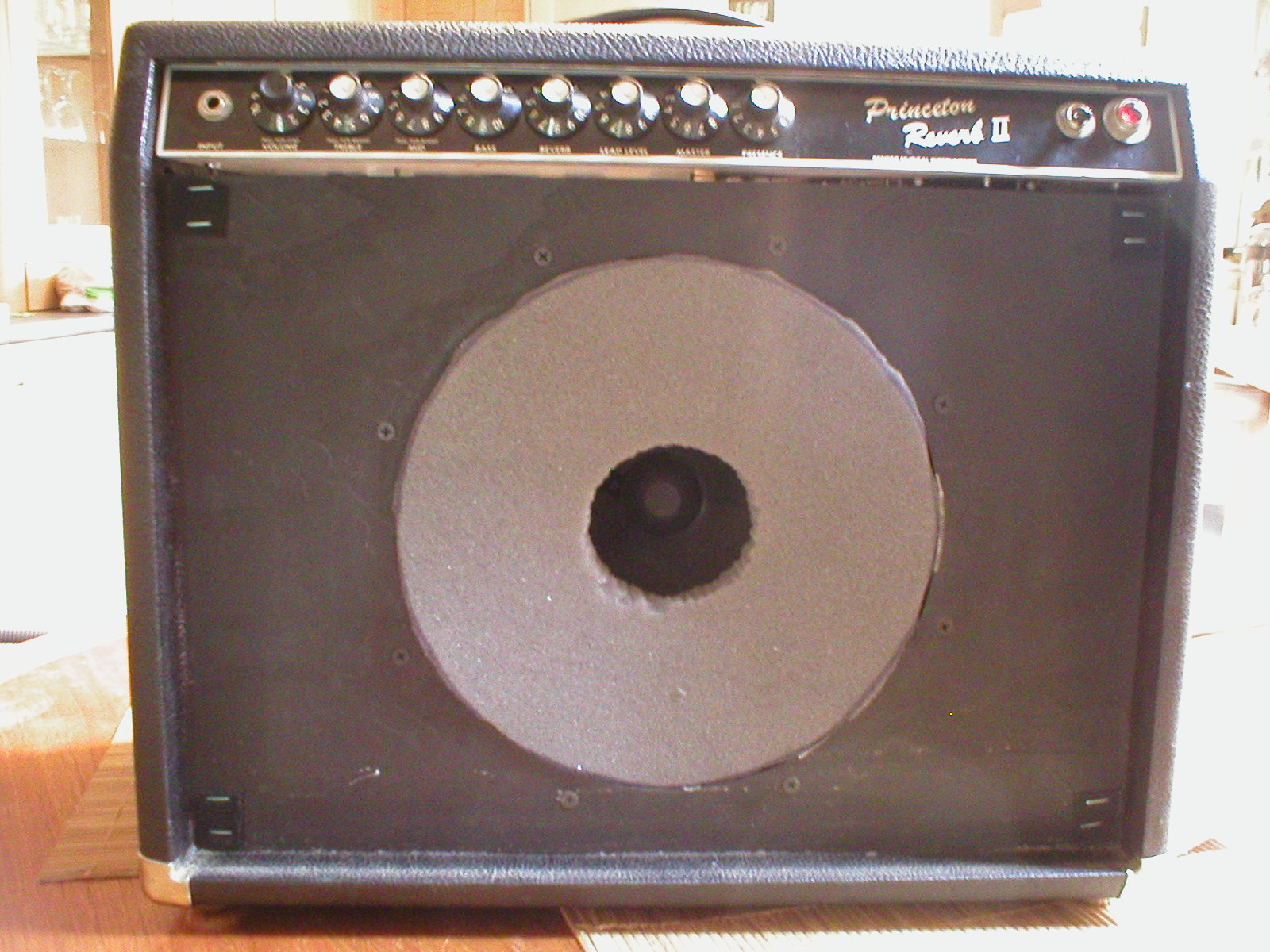This page is about a cheap and simple
cure for speaker
directivity, beaming, icepick highs - the problem for
some
(not all) electric players, in which the guitar sound contains much
more treble when listening directly in-line with the speaker, compared
with a more mellow sound when standing somewhere else in the room.
Often the guitarist sets up his amp to sound great to
HIM. But if the amp's close to him and on the floor, only his ankles
are 'hearing' the on-axis tone and he doesn't realise there are a few
people in the audience, directly in the firing-line,
who are being deafened by a narrow 'beam' of high-frequency tone. If he
aims the amp at his head, he will probably turn the treble down a
little, but now the audience and the rest of the band can't
hear it so well.
So there can be a lot of advantages in making the volume and tone more even over a wide spread of angle. This method is cheap, easy, and if you don't like it or change your mind, you can reverse it in less than 5 minutes. The original idea is from US loudspeaker scientist Jay Mitchell and his technical explanation is here. Please don't contact me concerning the explanation of how it works - you don't have to understand it, but if you want to, show it to someone who did high school physics and can remember the bits about waves, interference, and diffraction! Or you can look here for the Gear Page thread where Mr.Mitchell himself launches the idea and then deals, over and over again, with people asking questions which were answered in his original article. At the time of writing this page, that discussion was over fifty pages long....
 The foam is flat, open-cell
acoustic foam. In the US, people seem to
buy it from McMaster-Carr, part # 85735K72. In the UK I found efoam.co.uk very quick
and helpful (and thanks, Peter Farrington, for the tip-off). One sheet
300mm square, 18mm thick cost £8 and they
offer you another one for an extra 80p (April 2010). Whatever, the
inventor
recommends the density should be about 2lb per cubic foot (32 Kg per
cubic metre).
The foam is flat, open-cell
acoustic foam. In the US, people seem to
buy it from McMaster-Carr, part # 85735K72. In the UK I found efoam.co.uk very quick
and helpful (and thanks, Peter Farrington, for the tip-off). One sheet
300mm square, 18mm thick cost £8 and they
offer you another one for an extra 80p (April 2010). Whatever, the
inventor
recommends the density should be about 2lb per cubic foot (32 Kg per
cubic metre).
As Mr.Mitchell says, in practice it's almost trivial to implement. Here's my PRII with a Jensen C12N reissue speaker and a doughnut of 18mm (3/4") thick acoustic foam.
The PRII has a rear-mounted speaker, so the donut has to go on the front. The grille-cloth is detachable on a frame about 14mm thick, so that's the thickest foam you can use if you want to stick it on the back of the grille-cloth or on the front of the baffle board. (Any thicker and the grille-cloth will bulge). After reading some of the Gear Page discussion, I wanted to try 18mm. The baffleboard is about 20mm thick, so I cut the circle of foam you can see here, just a little over-sized for the hole. It fits snugly into the speaker hole. The brown things are the backing-paper of strips of double-sided tape, which now hold the foam in place (it seemed to stay there OK without the tape, but this is the safe approach).

The speaker hole is 270mm in diameter but I suggest you make the donut a little bigger. The centre hole is 75mm (3") diameter as Jay Mitchell suggests - he also says this measurement isn't critical, and I note some people just find anything circular that's about 3" diameter and draw around it.
I made a cardboard template, 270mm diameter as accurately as I could. This photo shows it in place in the speaker hole, a nice interference fit. Then I drew around the template onto the foam, which made the circle on foam just a little bigger than 270mm.
 Here's the donut in place. This
mounting method
achieves 3 vital things - the foam doesn't touch the
speaker cone, air can't move around the outer edge of the donut, and
when the grille goes back into place the amp looks unmodified.
Here's the donut in place. This
mounting method
achieves 3 vital things - the foam doesn't touch the
speaker cone, air can't move around the outer edge of the donut, and
when the grille goes back into place the amp looks unmodified.
In my experience the result is what Jay Mitchell predicts. It's surprising how much treble passes through the donut; naturally I had to turn up the treble and cut the bass a little to get the tone I wanted. Also (because you can cut foam away but you can't put it back) I started with a centre hole of 70mm, but found this took away too much top end, and opened it up to 80mm, which is what you see here. That's about 30% more hole area than before.
The tone and volume now seem much more even, whether I'm kneeling down in front of the amp or standing the same distance some way to the side. And that's the desired effect.
So there can be a lot of advantages in making the volume and tone more even over a wide spread of angle. This method is cheap, easy, and if you don't like it or change your mind, you can reverse it in less than 5 minutes. The original idea is from US loudspeaker scientist Jay Mitchell and his technical explanation is here. Please don't contact me concerning the explanation of how it works - you don't have to understand it, but if you want to, show it to someone who did high school physics and can remember the bits about waves, interference, and diffraction! Or you can look here for the Gear Page thread where Mr.Mitchell himself launches the idea and then deals, over and over again, with people asking questions which were answered in his original article. At the time of writing this page, that discussion was over fifty pages long....
As Mr.Mitchell says, in practice it's almost trivial to implement. Here's my PRII with a Jensen C12N reissue speaker and a doughnut of 18mm (3/4") thick acoustic foam.
The PRII has a rear-mounted speaker, so the donut has to go on the front. The grille-cloth is detachable on a frame about 14mm thick, so that's the thickest foam you can use if you want to stick it on the back of the grille-cloth or on the front of the baffle board. (Any thicker and the grille-cloth will bulge). After reading some of the Gear Page discussion, I wanted to try 18mm. The baffleboard is about 20mm thick, so I cut the circle of foam you can see here, just a little over-sized for the hole. It fits snugly into the speaker hole. The brown things are the backing-paper of strips of double-sided tape, which now hold the foam in place (it seemed to stay there OK without the tape, but this is the safe approach).
The speaker hole is 270mm in diameter but I suggest you make the donut a little bigger. The centre hole is 75mm (3") diameter as Jay Mitchell suggests - he also says this measurement isn't critical, and I note some people just find anything circular that's about 3" diameter and draw around it.
I made a cardboard template, 270mm diameter as accurately as I could. This photo shows it in place in the speaker hole, a nice interference fit. Then I drew around the template onto the foam, which made the circle on foam just a little bigger than 270mm.
In my experience the result is what Jay Mitchell predicts. It's surprising how much treble passes through the donut; naturally I had to turn up the treble and cut the bass a little to get the tone I wanted. Also (because you can cut foam away but you can't put it back) I started with a centre hole of 70mm, but found this took away too much top end, and opened it up to 80mm, which is what you see here. That's about 30% more hole area than before.
The tone and volume now seem much more even, whether I'm kneeling down in front of the amp or standing the same distance some way to the side. And that's the desired effect.
Big
thanks to Jay Mitchell for putting his idea in the public domain.